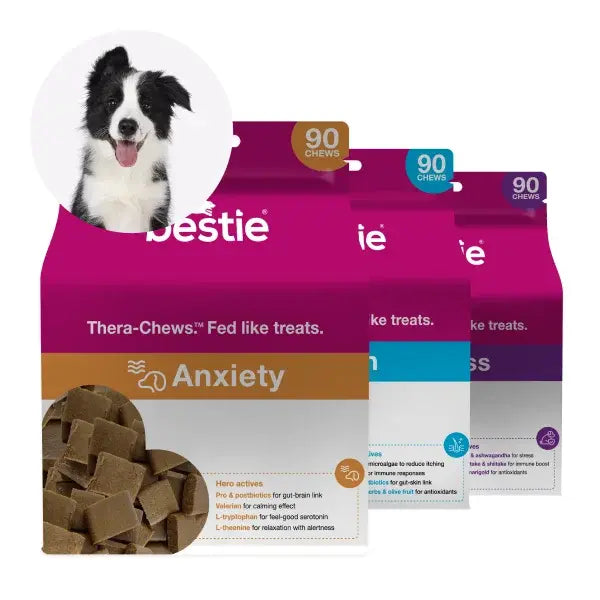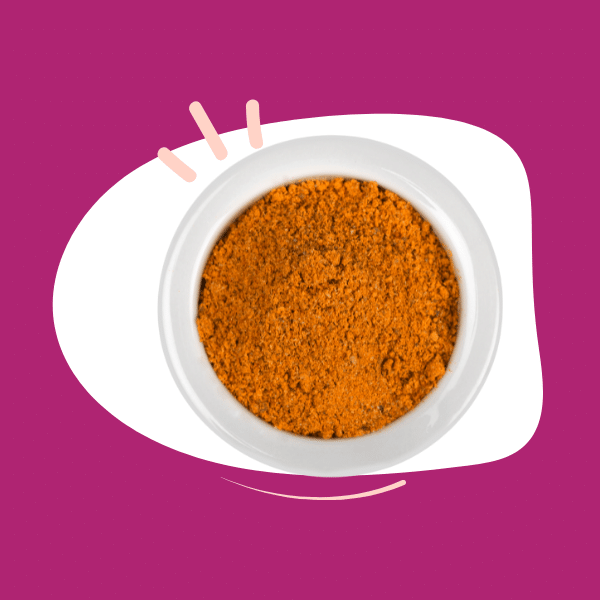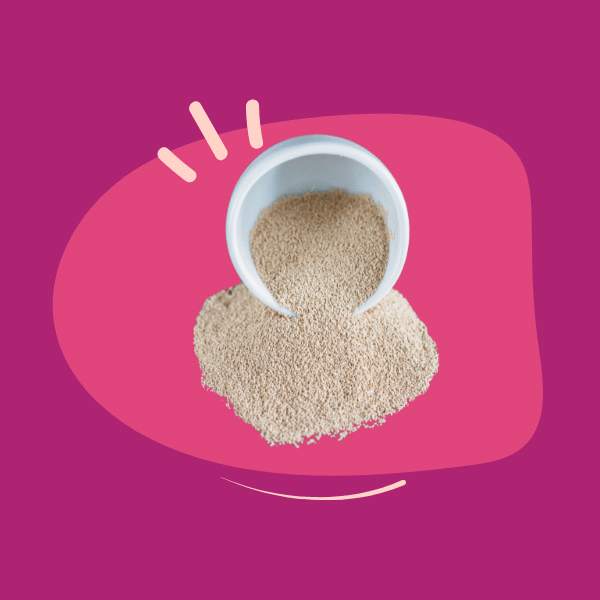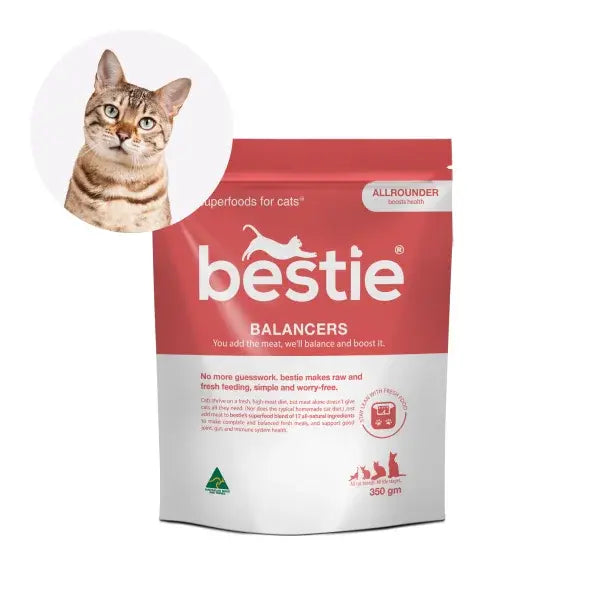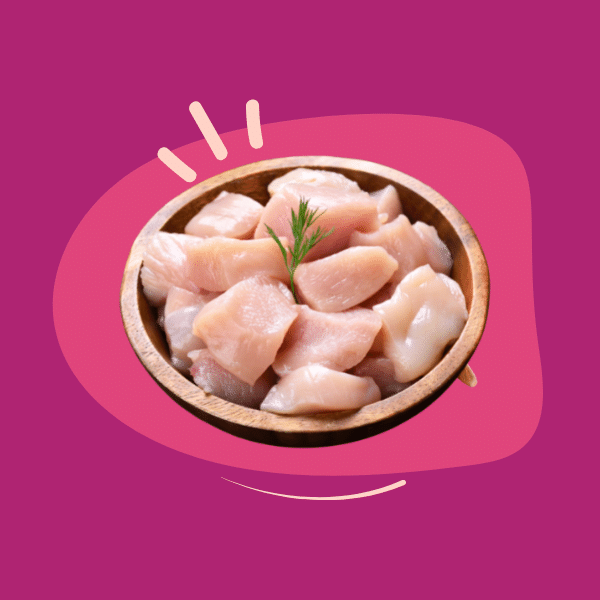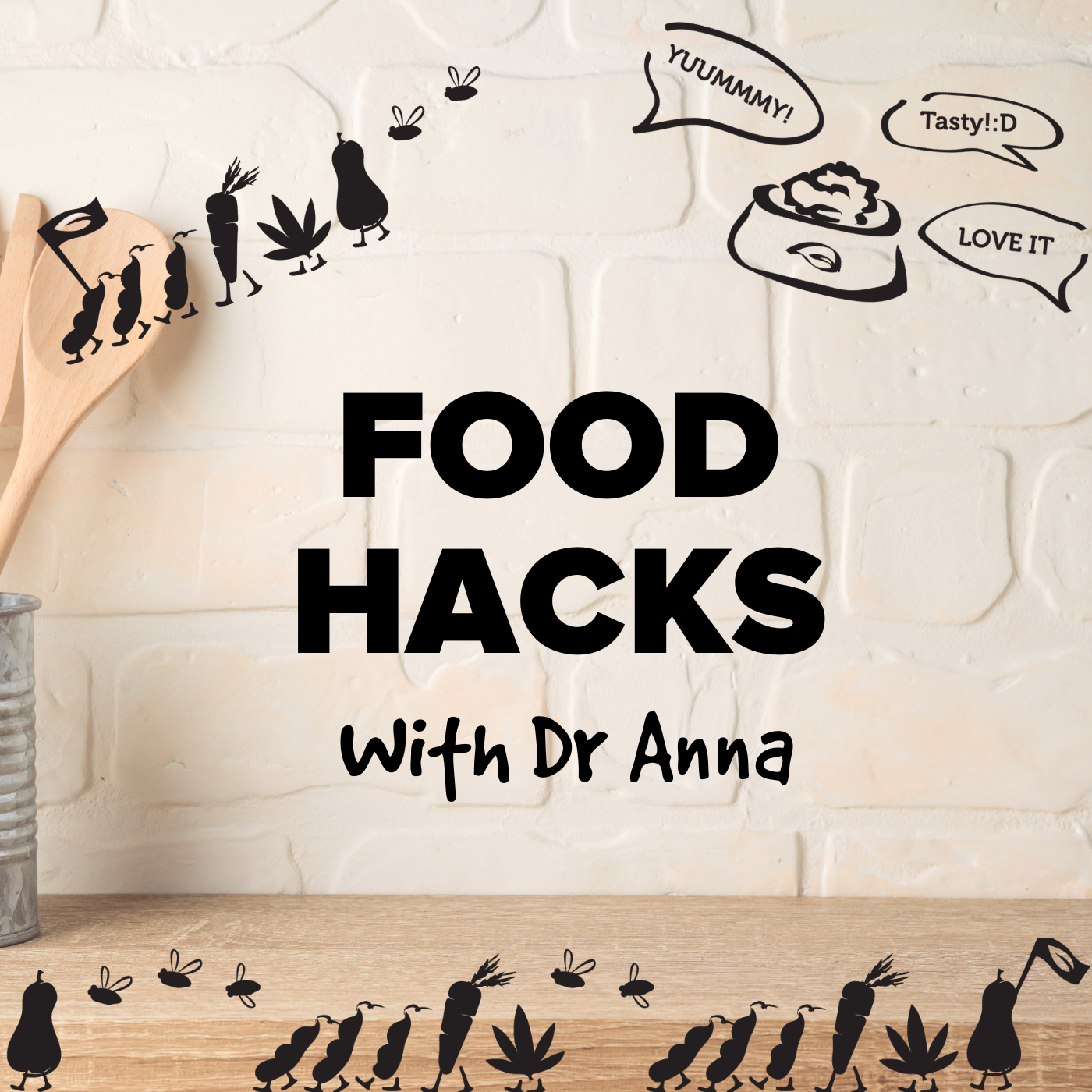In a nutshell:
-
Chicken is an affordable protein source that can be added to your dog’s diet.
-
There is the risk of bacteria affecting you and your dog’s health if feeding raw chicken. Goody hygiene and reputable sources of meat are important.
-
“Gently cooked” chicken is a great method to preserve nutrients and improve digestibility.
-
Chicken is a complete protein, but not a balanced diet on its own = Need to add a balancing supplement (like bestie’s Allrounder) and include other protein sources in a rotational meal plan!
Did you know that chicken is the most popular meat in Australia? We eat nearly 50kg of chicken per person every year. One of the reasons is its affordability; when this study was done in 2017, chicken was about half the cost of pork, beef, or lamb products(ACMF, 22).

This is a key reason why pet parents who’ve transitioned to a raw diet will ask themselves. “Can dogs eat raw chicken?”.
The simple answer is - Yes… but if only it were that simple.
Although chicken provides your dog with a source of digestible proteins, it also introduces some aspects that we, as pet guardians, need to consider.
So, let’s talk about chicken and highlight what you should know before adding chicken to your dog’s raw diet.
What nutrients does chicken meat have?
For many of us, the difference between chicken and other meats comes down to white versus red meat. However, we need to look at the nutritional value of chicken meat if you’re considering adding chicken to your dog’s diet.
A study published in Food & Nutrition Research found that chicken meat provides(Marangoni et al., 2015):
- Moderate energy content = Lean meat
- Highly digestible proteins = Low levels of collagen increases digestibility
- Complete protein source = Satisfies essential amino acid requirements
- Source of B vitamins = Mainly vitamin B1, B5, and B6 necessary for metabolising nutrients into usable energy.
Macronutrients - proteins and fats
The nutrients chicken provides your dog varies based on which part of the chicken you’re feeding. Typically, your dog requires at least 18% of its diet to be composed of crude protein on a dry matter basis(AAFCO, 2014).
When we compare the protein content of chicken wings, legs, and breasts, their protein content varies. For example, raw chicken breast had the highest protein content at 21%, compared to 17% in chicken legs and wings(Kim et al., 2017). This means we need to consider which part of the chicken to feed and adjust the proportions accordingly!
There’s also a lot of variation in the fat content of chicken. Let’s continue using the chicken breast as our example. Although the meat is quite lean (1% fat), keeping the skin on increases the fat content to 17%(Marangoni et al., 2015). Is this okay? Can dogs eat chicken skin?
Diets with +20% fat are considered high-fat, but studies have shown that this much fat can still be manageable if your pet’s energy requirements are balanced(Roberts et al., 2018).
Too much fat negatively impacts digestion and promotes obesity, so it’s important to consider how much fat we’re adding to our dog’s raw diet just by leaving the skin on. Fortunately, chicken skin for dogs also has its advantages since most of this fat is unsaturated and provides a source of omega 6 and arachidonic acid!
At Bestie Kitchen, we recommend feeding your dog or cat lean cuts of meat and supplementing additional fat through sources like fish oil. Have a look at our Allrounder Balancing Supplement and you’ll see we’ve added cod liver oil to ensure your pet is getting the right amount of fats from their raw diet, as well as good sources of omega 3 and 6!
Chicken and allergies
Food allergies vary on a case-by-case basis, and sometimes it can be hard to tell if your dog has an allergy or food intolerance. Often, dogs show typical symptoms like poor digestion and irritated skin - both indicators that your dog may be reacting to allergens in their diet.
A review of 19 different studies looking at 297 dogs found beef to be the most common dietary allergen (34%), followed by chicken (15%), then lamb (5%)(Mueller et al., 2016).
However, just because 15% of the dogs in this study were allergic to chicken, doesn’t mean you should necessarily avoid chicken. Although there’s no perfect way to prevent allergies, one approach is to make sure your dog has variety in its diet. For this, we can use a rotational meal plan. We’ll talk more about this below.
How to make chicken for your dog?
A big concern with feeding your dog chicken comes down to pathogens. Salmonellais consistently found in fresh-frozen raw dog food diets commercially available across Europe and North America(Davies et al., 2019). Here in Australia, a report released by New South Wales Food Authority detected Salmonellain 21% of chicken sent for meat processing in 2020 - emphasising the importance of proper food hygiene when handling chicken(Food Authority, 2020).
Raw chicken for dogs
Since there is no cooking involved, feeding your dog raw chicken does involve the risk of Salmonella infection. Whether you’re cleaning up your dog’s food bowl, getting kisses after a meal, or picking up their poo, there’s always a risk of spreading Salmonellato you and your family if you’re feeding your dog raw chicken(Davies et al., 2019).
Just one Salmonella contaminated-meal is enough to produce dog poo capable of spreading Salmonella for 11 days (Finley et al., 2007)! Even if it doesn’t directly affect your dog, this is a big problem for people who are immunocompromised or elderly - putting them at greater risk of infection.
On a similar note, if you’re wondering whether puppies can eat raw chicken, you’re better off with cooked chicken. The developing immune system in puppies is fragile and the potential threat of a Salmonella infection can be a significant health risk.
(That said, we've never had an issue ourselves, so use your judgement. This isn't a blanket statement against raw feeding either, to be clear.)
Gently cooked chicken for dogs
Raw diets provide pure and unaltered nutrients, but sometimes gently cooked food can be more digestible.
Recent studies have shown that chicken fed through a gently cooked diet is a better alternative. For example, when comparing raw and gently cooked chicken, the apparent total tract digestibility (ATTD) of crude protein was higher after gentle cooking(Algya et al., 2018).
Another study found steamed chicken improves amino acid retention and protein digestibility compared to raw diets(Oba et al., 2019). This means your dog can make better use of the nutrients they’re eating while preventing the added risk of bacterial contamination.
The key is “gently cooked”. For chicken to be safe to eat, the NSW Food Authority in Australia recommends the internal temperature must reach 74ºC. This is because harmful bacteria are destroyed at this temperature without overcooking the meat and damaging nutrients.
Boiled chicken for dogs
If you don’t have a thermometer, the safest option is to boil your chicken. If you’re using boneless chicken, 12-15 minutes is enough to destroy any harmful bacteria - extend this to 30 minutes if you’re using bone-in chicken.
Although boiling chicken is the safest option, it also has some disadvantages. First, we want to avoid overcooking the chicken. This decreases the digestibility of proteins because of molecular interactions with fats and carbohydrates, but we also lose a lot of nutrients into the water. Our goal is to cook the chicken, not to make chicken broth.
What’s the right raw meat for dogs?
While chicken is considered a complete protein source, it isn’t a balanced diet on its own. (In fact, no meat is.) Your dog needs over 30 essential macro and micronutrients every day, and these can't all come from the same food source. Besides, eating the same thing every day gets boring!
Although chicken provides all 10 essential amino acids that your dog needs, the composition of these amino acids varies compared to beef, lamb, and pork.

Once your dog digests the chicken and breaks down the protein into amino acid “building blocks”, there’ll always be more of some amino acids and less of others. For instance, chicken meat is high in methionine - a crucial amino acid needed to produce other important amino acids like cysteine and taurine(Kim et al., 2017). While chicken is high in methionine, most red meats (beef, lamb, pork) are relatively low.
The story is similar regarding micronutrients like vitamins and minerals. Compared to red meats, chicken provides less iron, zinc, and vitamin B12 (Williams, 2007). To avoid nutritional deficiencies, it’s essential to include a variety of meats into your dog’s raw diet. Using balancing supplements (like bestie’s Allrounder balancing pre-mix) and rotational feeding is one way to achieve this!

So the question we should be asking is:
“How can I incorporate different meats into my dog’s diet?”
You can start by selecting 2-3 meats and slowly introduce them into your dog’s diet. This helps their immune system become familiar with different food sources and avoid the development of allergies, in essence, using a technique similar to oral immunotherapy(Anvari & Anagnostou, 2018). This way, pet parents can take a preventative approach to allergies while making sure their dog is getting a complete and balanced diet.
Here you can learn more about the importance of rotational meal plans.
In summary
Although chicken is a high-quality protein that provides many of the nutrients your dog relies on, it still isn’t the “perfect” food source. The truth is, there is no such thing as a perfect food source. All protein sources have their strengths and weaknesses - this is when a rotational meal plan shines! (And a balancing supplement is needed.)
Of course, chicken is a favourable option for many pet owners because it’s affordable, but there are also concerns regarding hygiene and pathogens. So, if you’re thinking of adding chicken to your dog’s diet, it would be a good idea to gently cook the chicken and remove the potential risk of infection.
If you’re just starting a raw or gently cooked diet, consider combining poultry, red meat, and fish into your rotational meal plan to provide different sources of vitamins, minerals, and healthy fats.
Eat up!
References
AAFCO. (2014). AAFCO Methods For Substantiating Nutritional Adequacy Of Dog And Cat Foods. In.
ACMF. (22). Australian Industry Facts & Figures. In A. C. M. Federation (Ed.).
Algya, K. M., Cross, T. L., Leuck, K. N., Kastner, M. E., Baba, T., Lye, L., . . . Swanson, K. S. (2018). Apparent total-tract macronutrient digestibility, serum chemistry, urinalysis, and fecal characteristics, metabolites and microbiota of adult dogs fed extruded, mildly cooked, and raw diets1. J Anim Sci, 96(9), 3670-3683. https://doi.org/10.1093/jas/sky235
Anvari, S., & Anagnostou, K. (2018). The Nuts and Bolts of Food Immunotherapy: The Future of Food Allergy. Children (Basel), 5(4). https://doi.org/10.3390/children5040047
Davies, R. H., Lawes, J. R., & Wales, A. D. (2019). Raw diets for dogs and cats: a review, with particular reference to microbiological hazards. J Small Anim Pract, 60(6), 329-339. https://doi.org/10.1111/jsap.13000
Finley, R., Ribble, C., Aramini, J., Vandermeer, M., Popa, M., Litman, M., & Reid-Smith, R. (2007). The risk of salmonellae shedding by dogs fed Salmonella-contaminated commercial raw food diets. Can Vet J, 48(1), 69-75.
Food Authority, N. (2020). Annual Food Testing Report. In.
Kim, H., Do, H. W., & Chung, H. (2017). A Comparison of the Essential Amino Acid Content and the Retention Rate by Chicken Part according to Different Cooking Methods. Korean J Food Sci Anim Resour, 37(5), 626-634. https://doi.org/10.5851/kosfa.2017.37.5.626
Marangoni, F., Corsello, G., Cricelli, C., Ferrara, N., Ghiselli, A., Lucchin, L., & Poli, A. (2015). Role of poultry meat in a balanced diet aimed at maintaining health and wellbeing: an Italian consensus document. Food Nutr Res, 59, 27606. https://doi.org/10.3402/fnr.v59.27606
Mueller, R. S., Olivry, T., & Prélaud, P. (2016). Critically appraised topic on adverse food reactions of companion animals (2): common food allergen sources in dogs and cats. BMC Vet Res, 12, 9. https://doi.org/10.1186/s12917-016-0633-8
Oba, P. M., Utterback, P. L., Parsons, C. M., de Godoy, M. R. C., & Swanson, K. S. (2019). Chemical composition, true nutrient digestibility, and true metabolizable energy of chicken-based ingredients differing by processing method using the precision-fed cecectomized rooster assay1. J Anim Sci, 97(3), 998-1009. https://doi.org/10.1093/jas/sky461
Roberts, M. T., Bermingham, E. N., Cave, N. J., Young, W., McKenzie, C. M., & Thomas, D. G. (2018). Macronutrient intake of dogs, self-selecting diets varying in composition offered ad libitum. J Anim Physiol Anim Nutr (Berl), 102(2), 568-575. https://doi.org/10.1111/jpn.12794
Williams, P. G. (2007). Nutritional composition of red meat (M. a. H. Faculty of Science, Trans.). In. Wollongong, Australia.



